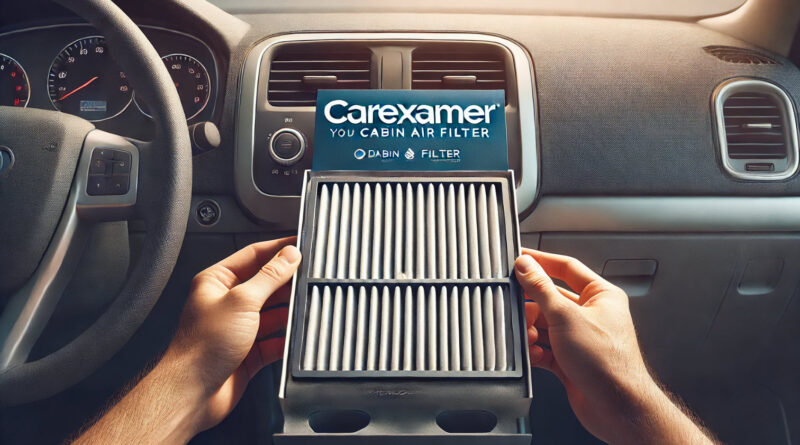Guide to Cabin and Pollen Filters – Get Your Car Ready for the Summer
In this guide, we’ll explain what these cabin and pollen filters do, why they’re important, and how you can maintain them to ensure your car is ready for summer. As summer approaches, ensuring your vehicle is ready for the warmer months is essential for a comfortable and safe driving experience. One often-overlooked component that plays a crucial role in your car’s air quality is the cabin or pollen filter.
What Are Cabin and Pollen Filters?
A cabin filter, also known as a pollen filter, is designed to clean the air that enters the vehicle’s interior through the HVAC system (heating, ventilation, and air conditioning). It helps remove dust, pollen, dirt, and other pollutants, ensuring the air inside the car is clean and free of allergens.
There are different types of cabin filters:
- Particulate filters: These trap dust, pollen, and debris.
- Activated carbon filters: These filters not only trap particles but also absorb harmful gases and unpleasant odors, providing additional protection against pollution.
Why Cabin and Pollen Filters Are Important for Summer
During summer, as pollen counts rise and outdoor dust and debris become more prevalent, your cabin filter plays an even more vital role in keeping the air inside your vehicle clean. Here’s why it’s crucial to check your cabin and pollen filters before summer:
- Allergen Control: Summer often brings higher pollen levels, which can trigger allergies. A clean cabin filter reduces the amount of pollen entering your vehicle, creating a more comfortable environment for passengers with sensitivities.
- Cleaner Air: Dust and pollutants are more likely to circulate during dry, hot months. Your cabin filter keeps these out of your car, ensuring you’re breathing clean air while driving.
- Improved HVAC Performance: A clogged filter can hinder your car’s HVAC system, making it harder to cool the vehicle. Replacing a dirty cabin filter improves airflow, allowing your air conditioning to function more efficiently—essential during those hot summer days.
- Odor Reduction: If you’ve noticed unpleasant smells inside your car, a dirty cabin filter could be to blame. Replacing it can help eliminate musty odors caused by trapped dirt and debris.
Signs Your Cabin or Pollen Filter Needs Replacing
Before summer sets in, check if your cabin or pollen filter needs replacing. Here are common signs that it’s time for a new filter:
- Reduced Airflow: If you notice that the airflow from your air conditioning vents is weaker than usual, it’s a strong indicator that the cabin filter is clogged.
- Unpleasant Odors: Musty or foul smells coming from the air vents may suggest that your cabin filter is filled with dirt and mold.
- Increased Allergies: If you or your passengers are experiencing more allergy symptoms, such as sneezing or congestion, it could mean the filter is not effectively blocking pollen and allergens.
- Dirty or Discolored Filter: A visual inspection can reveal whether the filter is dirty. A new filter is typically white or off-white, but if it looks gray or brown and is covered in debris, it’s time for a replacement.
How Often Should You Replace Cabin and Pollen Filters?
Typically, cabin filters should be replaced every 12,000 to 15,000 miles, or at least once a year. However, depending on your driving conditions, you may need to change it more frequently. For example, if you drive in a dusty area or experience heavy pollen seasons, check and replace your filter more often.
Many vehicle manufacturers recommend checking the cabin filter during regular maintenance, such as oil changes, to ensure it’s still in good condition.
How to Replace a Cabin or Pollen Filter
Replacing your cabin filter is a straightforward process that you can often do yourself in a few minutes. Here’s a general guide:
- Locate the Filter: In most cars, the cabin filter is located behind the glove compartment or under the dashboard.
- Remove the Cover: Depending on your vehicle, you may need to unscrew or unclip the cover to access the filter.
- Remove the Old Filter: Gently pull out the old filter. Make sure to note the orientation of the filter so you can install the new one correctly.
- Install the New Filter: Insert the new cabin filter in the same position as the old one. Ensure it’s seated properly.
- Replace the Cover: Once the new filter is in place, reattach the cover and close the glove compartment or dashboard.
If you’re unsure how to locate or replace the filter, consult your car’s owner manual for specific instructions.
Benefits of Replacing Your Cabin Filter Before Summer
Replacing your cabin filter before summer brings several advantages:
- Better Air Quality: A clean filter ensures that you and your passengers breathe fresh, clean air during every trip.
- Efficient Air Conditioning: A new filter improves the performance of your air conditioning system, helping it cool the car more effectively.
- Allergy Prevention: Replacing a dirty filter reduces the amount of allergens, such as pollen and dust, that enter your vehicle, minimizing allergic reactions.
- Odor Control: New filters help eliminate unpleasant smells, leaving your car smelling fresh.
As summer approaches, now is the perfect time to check and replace your cabin and pollen filters. Not only will this improve the air quality inside your car, but it will also enhance the performance of your air conditioning system, keeping you cool and comfortable during the warmer months. By maintaining your cabin filter, you ensure a healthier, more pleasant driving experience throughout the summer season.
Remember, a well-maintained vehicle is key to enjoying your summer road trips and daily commutes. Make cabin and pollen filter replacement a priority to keep your car ready for the heat and allergens of the season.
Buying a used VW. Buying used vauxhall, BMW, Jaguar, Ford, Volvo, Range rover, Bentley, Aston Martin, Porsche, Ferrari, Lamborghini, Maserati, Hyundai, Tesla, Honda, Pagani

